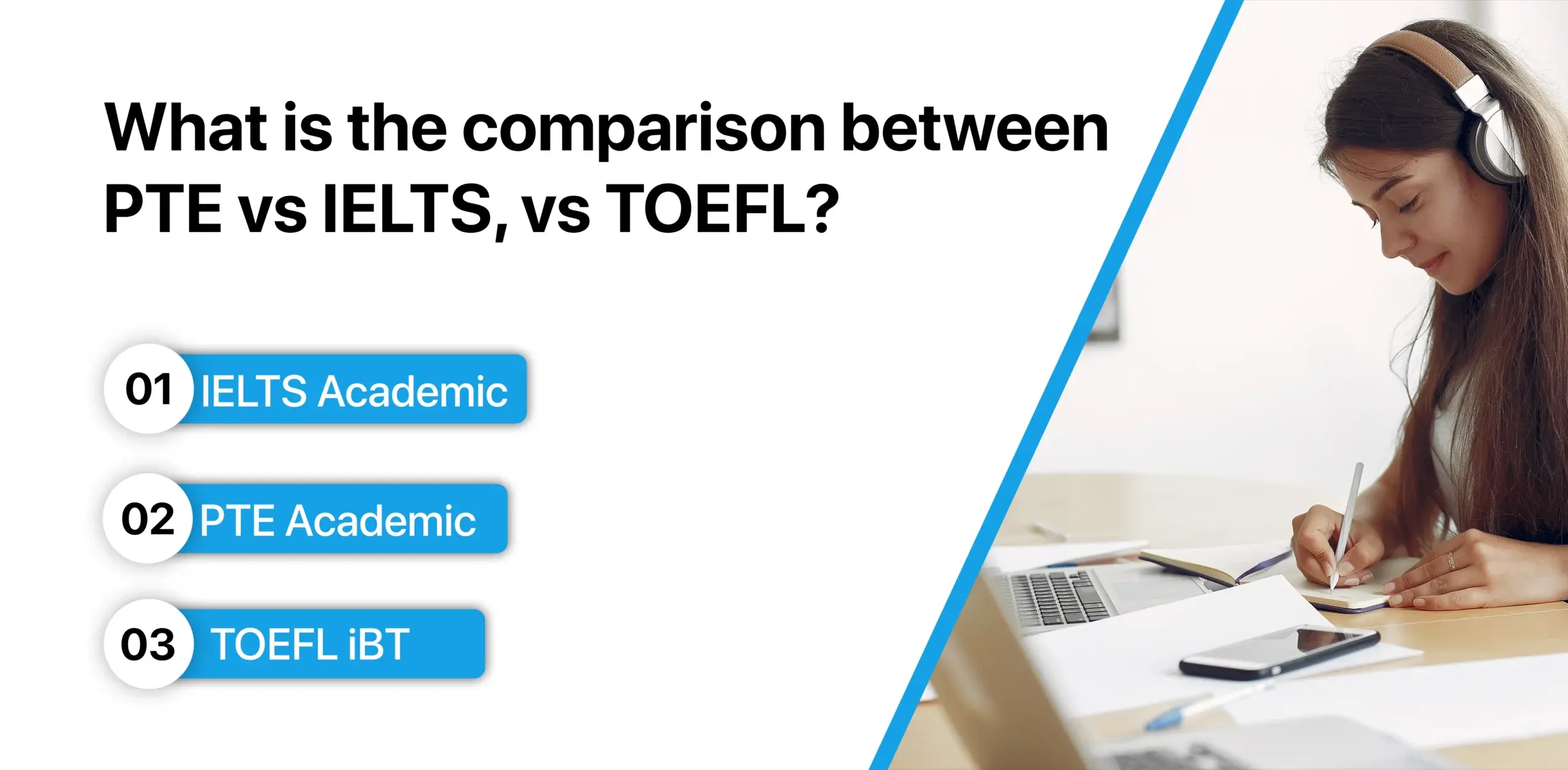If you plan to study, work, or even apply for Australian Permanent Residency (PR), you must prove your English language skills. The Australian government requires that all visa applicants in most visa categories possess excellent mastery of the English language, usually through an English proficiency test that is recognised.
Even though it has a number of alternatives (i.e. IELTS and TOEFL), PTE (Pearson Test of English) has become the English proficiency examination of choice in Australia.
PTE has significantly good opportunities compared to others because of the speedy results, objective and impartial scoring, and high acceptance in the Australian immigration and high school requirements.
In this blog, we’ll dive deep into what makes PTE for Australia the go-to choice for thousands of international applicants.
What is PTE (Pearson Test of English)?

The PTE Academic is an entirely English-language test. This examination evaluates listening, speaking, reading, and writing abilities in one and a half hours of testing time. It is also technology powered by AI scoring, which makes it both unbiased and consistent when it comes to assessing test takers of every background.
The Important Aspects of the PTE Exam:
- Fully Computer-Based: No human examiners means it is impartial.
- AI Scoring: It comes with complex algorithms that evaluate performance without bias.
- Speedy Results: The results are usually out in 1 to 2 days.
- International Acceptance: Welcomed by governments and thousands of universities all over the globe.
- Official Acceptance: Approved by the Australian Department of Home Affairs to cover all the major visas.
Be it a student visa, a work visa, or a PR, PTE Academic covers the language requirement in an efficient, streamlined manner.
Why is PTE the Preferred English Proficiency Test for Australia?

What are the main reasons PTE Australia is increasingly becoming the number one choice among international students, skilled workers, and applicants to PR? Let us look into some important reasons.
1. Well-known Tradition among Australian Officials
Among the most compelling arguments to follow PTE, one can count the fact that the Australian Department of Home Affairs endorses it. The PTE Academic is accepted in all regions, whether on a student visa, temporary graduate visa, skilled migration visa, employer-sponsored visa, or permanent residence (PR).
Such wide acceptance means that the candidates need not be concerned with whether a student will be compatible or eligible enough to submit their English test scores along with their visa applications.
2. Quick Analyses
You usually have little or no time, perhaps when it comes to visa requirements or on-time university applications. The results of the PTE test normally take between 1 and 2 business days, as compared to other English tests that can take a week or even more to deliver the results.
This is because it eliminates the anxiety that is created by the waiting time that comes with the scores and also enables a candidate to plan the next stage with a lot of comfort.
3. Fair scoring and Computer-Based
The other outstanding feature of the PTE exam is that it has fully automated AI scoring. The fact is that there are no human examiners to participate in the test, and the whole test is reviewed through sophisticated algorithms.
The result? An equitable, consistent, and non-discriminative experience of taking an English test by every test taker, independent of his or her accent, background, or nationality. There is no doubt that the candidates can be sure that their performance results are not subjective.
4. Adjustable Opening and Closing Dates and Places
PTE is more flexible in regard to the schedule. The test dates are frequent and spread throughout the year, and test centres are distributed throughout Australia and around the world, which allows a candidate to select a time and a place that is most convenient to him or her.
PTE is flexible compared to IELTS and TOEFL, and this provides the test candidates with a greater sense of control.
5. Simple Test Format
The PTE Academic is comprehensive and efficient. The whole test takes approximately two hours in one sitting and can be taken without the necessity to visit on different days since it consists of the following components: speaking, writing, reading, and listening.
This stripped-down format will aid in minimising tiredness, and the test will seem less daunting even to a person taking the test on their first attempt. It is the intuitive format as well, which allows candidates to be more focused in the exam and better manage their time.
What is the comparison between PTE, IELTS, and TOEFL?

1. PTE Academic
PTE Academic is a fully computer-based English test, which employs artificial intelligence to score the test and therefore provides a fast, fair, and unbiased measure of the English level. The complete test lasts about 2 hours, in which one tests all four areas of language skills—listening, reading, writing, and speaking—at once.
High speed: PTE has one of the fastest results delivery times and can sometimes be expected within a span of 1 to 2 days, and hence it is this quick delivery time that makes PTE the answer to time-bound applications like student visas or PR applications.
All the Australian visas and the majority of Australian learning institutions accept it. Its price is approximately AUD 410, and the flexibility of booking it in terms of online and centre-based formats makes it extremely convenient.
2. IELTS Academic
IELTS Academic is one of the recognised English tests that has a high level of recognition all over the world and is also recognised by Australian visa types.
The test will take about two hours and forty-five minutes, and the individual tests are for reading, listening, writing, and speaking. Speaking is often tested separately. IELTS integrates the use of both human and automated scoring, which can add subjectivity to a scoring system, particularly in speaking and writing.
The time taken to acquire results ranges between 5 and 13 days, depending on the design of the test being utilised. Similar to PTE, IELTS has a price of around AUD 410, yet its length and the people interacting with it may act as a negative aspect in the eyes of some examinees.
3. TOEFL iBT
Another widely known test in English and also popular in North America is the TOEFL iBT, which is accepted by most Australian institutions and visa types, but not every one of them. It is fully computerised, and the test can take approximately 3 hours. Just like in IELTS, TOEFL employs a mix of human and computerised grading, but unlike IELTS, it gives a result within 4-8 days.
The price is around AUD 300-400; thus, it is a bit cheaper than PTE or IELTS. Nevertheless, its recognition on some Australian visa types could be disadvantaged, and its test contents are more academic in turn, which could be a capability challenge to the general migration population.
PTE Scoring System and Minimum Requirements for Australia
Your mastery of the English language is an important factor in the application for a visa when you are planning to study, work, or migrate to Australia permanently. Another exam that is widely accepted by the Australian Department of Home Affairs is the Pearson Test of English (PTE Academic).
Becoming familiar with the PTE scoring system and the essentials of the score to obtain the desired visa in Australia will give you better self-definition and set clear goals, as well as better preparation.
During this section, we will explain the PTE score requirement, PTE Australian PR, PTE student visa, and PTE work visa, and how the PTE score will match with IELTS band scores, to allow easy comparison.
PTE Score Student Visa (Subclass 500)
In case you have decided to study in Australia, the chances are that you will have to obtain the Student Visa (Subclass 500). Most educational institutions and visa applications require at least a PTE Academic score of between 42 and 50 to fulfil the English language requirement. But all this can depend on the level of courses and the educational institution:
- Vocational education and training courses: 42-45 minutes
- B.A. programs: 50 57
- Postgraduate degree programmes: In most cases, the scores must be higher than 58
Depending upon your score, which is below the cut-off, some institutions can have English Language Intensive Courses for Overseas Students (ELICOS) where you will be able to master your English first before your actual course begins.
General Skilled Migration Program, and PTE Score (Work Visa (Subclass 485))
Applying for a Temporary Graduate Visa (Subclass 485) allows international students who have recently graduated from an Australian university to stay and gain work experience. The Department of Home Affairs defines proficient English usage as follows, which applicants must demonstrate to be eligible:
PTE Academic score of 50 or above in all 4 sections of the test
It implies that you have to score 50 or more points not only in total but also in speaking, writing, reading, and listening. The advantage of PTE for 485 applicants is that it is fast (usually between 1 and 2 days) and very wide in its distribution, and therefore, it is the place to be when needing to apply for a visa within a given time.
Australian PR (Permanent Residency) and Skilled Migration
When acquiring Australian Permanent Residency (PR) through the General Skilled Migration programme (which consists of such visas as the Subclass 189 (Skilled Independent), Subclass 190 (Skilled Nominated), and Subclass 491 (Skilled Regional) visas), your English language skills may affect your points count and, by extension, your eligibility directly.
The criteria for scoring are the following:
Good command of English (10 points): PTE Academic score of 65/section or above
Excellent English (20 points): PTE Academic score of 79 or above in all scores
The more points you score, the more points you get, and the higher your prospects of receiving an Invitation to Apply (ITA) within the points-tested skilled migration system of Australia. A score of 79+ in PTE Academic not only means that you are brilliant with the English language but also gives you an edge over others during the immigration procedure.
How to Register for the PTE Exam?

The Process of Registration for the PTE Exam.
When you intend to study in Australia, work in Australia, or migrate there, it is usually a necessary procedure to take the PTE Academic exam. Luckily, the PTE registration procedure is very simple and purely done online.
It only takes a few simple steps to register, whether you are doing the registration at a centre or you want to take the PTE at Home version of the test. Details of how one can book the PTE test and tips that one needs in order to make this process seamless and painless are given below.
Step 1: Visit the Official Pearson PTE Website
You can begin PTE registration at the official site:
https://www.pearsonpte.com
It is also the only official channel for registering for your PTE test, and you can get all the updated information concerning the types of tests, dates, and venues, as well as fees. It is highly advised not to use a third-party site, as it may lead to errors or overpayments.
Step 2: Pearson Account Create
When you do not have a Pearson account and need to create one, press the button labelled ‘Book Now’ or ‘Sign In’, and then follow the instructions.
You will be expected to give:
- Full name (as in your passport or ID)
- Email address
- Birth date
- Residence country
- A piece of identification (a passport in most cases of international test takers)
Ensure that the information you enter is in line with what is in your source of identification, or you will be denied a chance to take the test during the exam time.
Step 3: Select the Type of the Test: PTE Academic or PTE Core
When creating an account, you will choose the right type of test. To complete most of the visas and university requirements in Australia, you will have to decide upon:
- PTE Academic is accepted for student visas, skilled migration, and permanent residency
- PTE Core – slightly newer model that is used in Canadian and general English purposes (not the norm in Australian immigration purposes)
Unless you have received explicit instructions to the contrary, PTE Academic is the one to choose.
Step 4: Choose a Test Centre or Book PTE at Home
Lastly, find a place where a test is conducted. You will also be presented with a list of the test centres that have dates and time slots available. In the event that you want to test at home, select the Check option: PTE at Home (online proctored test).
The flexibility can enable you to take your exam at a convenient time, when it is available, and at a convenient travel destination.
Step 5. Choose your favourite date and time
Once a suitable location (or online test) has been identified, you can look up a time and date on the calendar. The test spots can be booked either during the week or at any centre, with real-time updates.
In case you have to rearrange your appointment in the future, you can do so conveniently online in your Pearson account. Though remember that there could be a rescheduling fee; it may be too late for the date of the testing.
Step 6: Pay the Test Fee
Once you have chosen your test slot, you go to the payment portal. The majority of PTE testing locations in Australia charge about AUD 410.
It is possible to pay by:
Credit/debit cards (Visa, MasterCard, and so on)
There are some regional payment or crypto wallets online
Once you pay the fee successfully, you will get a confirmation email with details of booking your test date, how to take the test on the day of your test, and a reminder about the ID you should carry with you.
What are the Tips to Prepare for the PTE Exam?

Although the Pearson Test of English (PTE Academic) might be shorter and less difficult in comparison with other English proficiency exams, the preparation process should also be intelligent. Cracking the PTE is much more than learning English; it is learning about the PTE, devising PTE strategies, and developing PTE practices the proper way.
When you are in a dilemma on how to crack the PTE with a high score, then the following detailed tips will help in fortifying your preparation and confidence before you sit the test.
1. Official PTE Practice Materials
Using Pearson’s official materials for practice is likely the best advice for PTE preparation. Such materials that resemble the actual presentation of the test include:
- Practice questions (all four modules of the Speaking, Writing, Reading, and Listening)
- Graded sample tests that provide you with a predicted PTE score
- Sample answers and a question bank to learn what a good answer is
You can find these materials on the Pearson site, and most of them are free. Alternatively, you can buy advanced practice packages. It will also eliminate the surprises on your examination day and make your practice more effective, as this is done using actual questions.
2. Practice Full-length Mock Tests in Real Conditions
Taking time-bound sample tests is also the best way to study for the PTE. Make all mock tests as natural as the real exam will be: sit at a desk and use a headset, and don’t forget about taking the whole test without distractions.
Mock tests will assist you:
- You will become accustomed to the 2-hour straight pattern
- Exercise to alternate fast between questions
- Find out your strong and your weak points
- Become a more effective time manager
A number of websites and coaching centres provide PTE trial papers along with score consequential tools. Some replicate the real testing conditions near perfectly, which is fantastic with regard to accruing test-day confidence.
3. Practice on a Computer using Headsets
The PTE Academic is entirely computer-based and therefore, doing a pen and paper exercise is insufficient. Be sure to:
- All your writing practice should be typed on a keyboard
- Record yourself speaking
- Headphones will be used, and the same questions will be asked to be listened to as in the real test centre.
This will be useful in getting acquainted with the digital version, lowering the number of mistakes made by typing under pressure, and acclimatising you to using technology tools in the examination room.
This is an aspect that many candidates will not pay much attention to, but familiarity with the interface can play a big part when working on the PTE.
4. Improve Speaking Skills with Clarity and Fluency
Speaking is another important component of the test, and since it is AI-graded, it examines your pronunciation, fluency, and clarity. To prosper:
Train yourself to talk normally and clearly, neither too fast nor too slow.
There should be no long pauses and fillers such as um or uh.
To check fluency and correctness, record yourself.
Apply a PTE-specific speaking practice, which includes but is not limited to the tasks of reading aloud and repeating a sentence.
The key point to remember is that you should not make yourself sound like a native speaker; just speak in a manner that is clear, fluent, and confident.
5. Time Management in each section mastered
In PTE, there are registered limits in each module, that is, Speaking & Writing, Reading, and Listening. Most of these test takers will either have some questions they did not finish within the time, or they will be in a hurry to get through the questions. To prevent this:
Find out the time-specific type of task given; best practice is to set your own pace to ensure you do not take too much time on one question.
Have a countdown clock in practice.
Listening is especially hard because, during listening, you will need to make notes and then immediately find the answer. It is important to practice under pressure so that when you are taking the test, you can do it effectively.
6. Understand Scoring Criteria for Each Section
The issue is that to get a good score, it is not only necessary to answer correctly, but also to understand how to get the money. For example:
- Writing is scored according to grammar, spelling, structure, and coherence.
- The speaking will be marked based on fluency and pronunciation.
- Reading is the interpretation of words and their correctness.
- Listening involves concentration and good note-taking.
This way, you can learn to answer questions in a way that aligns with what is expected to be treated as the right answer.
7. Pay More Attention to Your Weaknesses
Strengths and weaknesses of every test taker are possible. You may read very well and speak badly, or the other way around. You should take your practice tests to find out where you have problems and adjust your study plan.
And when you are weak in writing, you do more essay work.
And in case you take too long when reading, learn to do skimming and scanning.
In case listening is a morale issue, work on it through podcasts, news, and taking notes in practice.
Specific preparation will also make you improve your preparation speed as compared to merely repeating full mock tests.
8. Take a PTE Training course
When you have little time or it is really hard to gather and learn by yourself, then you may want to consider joining a PTE coaching centre or an online course. Some programmes provide:
- Formation of lessons by professional trainers
- Practice boards and response to performance
- personalised suggestions on your level
- One-on-one meetings or group meetings
Lots of learners need external support, particularly when they want to score the required balance of PTE scores (65+ or 79+) to get an Australian PR or work visa.
9. Keep yourself updated and practice
The format or the standards of the PTE assessment may be changed sometimes by Pearson, so it is necessary to be physically knowledgeable. Follow the useful blogs or forums, or subscribe to the updates.
Moreover, develop a habit of studying:
- Play four or five times a week, or every day.
- Start putting more emphasis as the date of your examination is near
- Corrections: What errors did you make? Keep a record of corrections
- The ability to exercise regularly helps in the development of speed, accuracy, and confidence.
Conclusion
The PTE Academic is not the sole English proficiency test in the entire scope of possibilities. Nonetheless, it has become very popular with the test-takers who intend to study, work, or settle in Australia.
Among the top features of the PTE Academic is the speed of obtaining the results, since they are generally announced within 1 to 2 days. This ensures that it is suitable for those who have strict timelines or deadlines in relation to visa applications.
Another outstanding feature of it is that it employs AI scoring technology that does not introduce the bias of the human factor and allows applying a fair and consistent score to each candidate, no matter his or her background or accent.
It is also nice to mention the ease of the booking process. It is extremely flexible, as those who want to take the test are able to do so online, select from a great number of test centres, or take the online at-home format.
Above all, the PTE Academic is popularly accepted by the Australian Department of Home Affairs. Having gained recognition among all of the significant types of visa, whether it is a student visa, a work visa, or even permanent residency (PR) avenues, it is a very viable option to offer applicants a rather extensive range of cases.
FAQs
1. Is PTE accepted for Australian PR?
Yes, PTE Academic is accepted for Australian PR by the Department of Home Affairs. It is recognised for skilled migration and other permanent residency visa categories.
2. How long is PTE valid for Australian visas?
PTE scores are valid for 2 years for most Australian visas and up to 3 years for PR applications.
3. Which is easier: IELTS or PTE for Australia?
PTE is often considered easier than IELTS due to its computer-based format, faster results, and unbiased AI scoring. However, it depends on individual strengths and test preferences.
4. Why choose PTE?
PTE offers fast results, fair AI scoring, easy booking, and is accepted for all major Australian visas.





